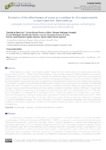Use este identificador para citar ou linkar para este item:
http://www.alice.cnptia.embrapa.br/alice/handle/doc/1072729| Título: | Evaluation of the effectiveness of ozone as a sanitizer for fish experimentally contaminated with Salmonella sp. |
| Autoria: | LUIZ, D. de B.  SILVA, C. D. F. e   CAMPELO, S. R.   SANTOS, V. R. V. dos   LIMA, L. K. F. de   CHICRALA, P. C. M. S.   IWASHITA, M. K. P.   |
| Afiliação: | DANIELLE DE BEM LUIZ, CNPASA; CARLOS DANGER FERREIRA E SILVA; SIMONE RODRIGUES CAMPELO, CNPASA; VIVIANE RODRIGUES V DOS SANTOS, CNPASA; LEANDRO KANAMARU FRANCO DE LIMA, CNPASA; PATRICIA COSTA M SOARES CHICRALA, CNPASA; MARINA KEIKO PIERONI IWASHITA, SNE. |
| Ano de publicação: | 2017 |
| Referência: | Brazilian Journal of Food Technology, Campinas, v. 20, e2016150, 2017. |
| Conteúdo: | Salmonellosis is a major public health problem related to food contamination and ensuing food poisoning. Brazilian resolution RDC nº 12/2001 of the Brazilian National Health Surveillance Agency (ANVISA) established the absence of Salmonella in 25 g of fish for consumption. However, the significant increase in the occurrence of fish contamination by Salmonella and other pathogenic bacteria shows that the currently applied strategies are not sufficient and that, in addition to the implementation of good health practices, the application of new sanitizer technologies in the fish industry is also necessary. In this context, the present study evaluated the effectiveness of ozone in an aqueous medium as a sanitizer for Salmonella contaminated fish. The experiment was carried out using a completely randomized design with eight treatments and five replicates, giving a total of 40 experimental units. Each sample consisted of three fishes, totalizing 120 fishes. The treatments consisted of different combinations of temperature and water-dissolved ozone (O3) concentrations (21 °C × 0.35 ppm; 20 °C × 0.45 ppm; 21 °C × 0.60 ppm; 20 °C × 0.80 ppm; 19 °C × 1.7 ppm; 6 × 5.1 ppm; 4 °C × 7.2 ppm; and 2 °C × 9.1 ppm). Colossoma macropomum (Tambaqui) samples were experimentally infected with Salmonella typhymurium (ATCC 14028) and immersed in water with the different treatments. After three minutes, the fish samples were collected and subjected to qualitative Salmonella analyses. The ozone tests were not efficient in eradicating Salmonella under the experimental conditions presented here, indicating the need for the identification of effective sanitizers in order to meet the determinations of Brazilian law. |
| Thesagro: | Tambaqui Peixe de água doce Microbiologia Colossoma macropomum Ozônio Salmonella |
| ISSN: | 1981-6723 |
| Digital Object Identifier: | 10.1590/1981-6723.15016 |
| Tipo do material: | Artigo de periódico |
| Acesso: | openAccess |
| Aparece nas coleções: | Artigo em periódico indexado (CNPASA)  |
Arquivos associados a este item:
| Arquivo | Descrição | Tamanho | Formato | |
|---|---|---|---|---|
| CNPASA2017bjft.pdf | 735,83 kB | Adobe PDF |  Visualizar/Abrir |









